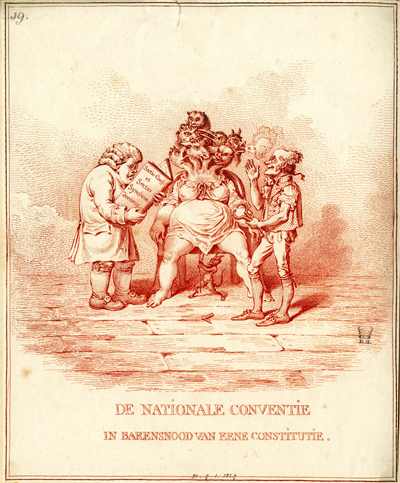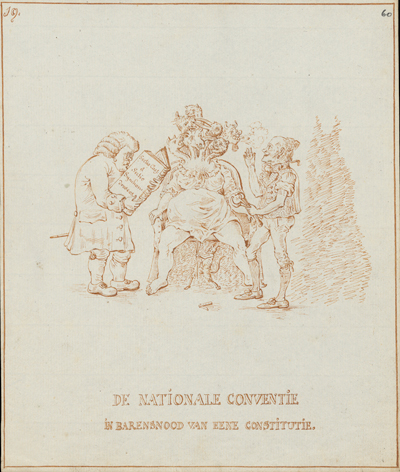De Nationale Conventie in Barensnood van Eene Constitutie
This is the nineteenth plate of a twenty plate series, Hollandia Regenerata, etched by Gillray based on drawings by the Swiss soldier, painter, and caricaturist, David Hess. For more about David Hess, and the political and artistic context of the series satirizing the newly-created and French-supported Batavian Republic, see my Introduction.
The title can be translated as "The National Assembly in Labor with a Constitution." It shows a monstrous pregnant woman with seven heads sitting in a chair awaiting the decision of two doctors—one Dutch and one French—about the correct process for delivering her child. The Dutch midwife seems lost in researching the issue, while the French "accoucheur" seems ready and eager to apply the forceps. A little devil between the woman's legs seems about to hasten the issue by breaking her waters. And meanwhile the seven heads of the woman are all fighting one another.

De
Nationale Conventie in Barensnood van Eene Constitutie
[1796?]
© Trustees of the British Museum
After prolonged and bitter battles in bodies like the Provisional Representatives of the People of Holland about who should be part of the electorate and who should be allowed to represent a given locale, the decision was made to create a National Convention with representatives from all over the Netherlands, and with a much greater toleration of minorities such as Catholics and Jews. Its first meeting was held in March 1796, and one of the first orders of business was to establish a new Constitution. The old Constition, which dated back to the Union of Utrecht in 1579 had been reviled by Patriots wishing for a truly unified Netherlands as 'the Seven-Headed Monster' because it placed most of the power in the hands of an elite group of representatives from seven provinces. In portraying the new National Assembly as a monstrous seven-headed woman Hess was co-opting a familiar image and at the same time recognizing the residual power of that paradigm.
As with all the plates in the series, the corresponding page to the image contains one or more appropriately ironic Biblical quotations in Dutch and English and a satiric "Explanation" in French. As usual the Biblical quotation represents Hess's most damning and pessimistic assessment.
Isaiah, xiv. 29. "Her fruit shall be a fiery flying serpent."
The "Explanation." is less apocalyptic, but it hints at the difficulty of the task and the very different approaches the French and the Dutch would take.
Il est doux d'être mêre! Mais le moment de le devenir, est quelques fois critique. Les têtes de cette Convention souffrante, annoncent suffisament ce qui se passe dans son bas ventre. L'accoucheur Français, homme experimenté, prévoit ses terribles convulsions, et s'est déja muni du forceps. Son collegue Hollandais, dont les craintes vont encore plus loin, repete la théorie de l'incision Caesarienne. Il faudrait effectivement un Caesar, pour couper court à tout proces!
And here is my free English translation.
It is sweet to be a mother. But the moment of becoming one is sometimes critical. The multiple heads of this suffering Convention, sufficiently suggest what is happening below. The French male midwife, an experienced man, has anticipated her terrible convulsions, and has already furnished himself with a forceps. His Dutch colleague, whose fears go even further, prepares for a Caesarean section. It would effectively take a Caesar to cut short the process!
The French midwife is of course experienced having presided over the "terrible convulsions" of a similar birth in revolutionary France, and his method is appropriately violent and mechanical. Famously slow and indecisive, the Dutch midwife seems scarcely to notice his patient, consumed in his reading of a weighty tome about what appears to be two different surgical approaches. In fact, Hess was fairly prescient in his depiction. The unitarists among the Patriots continued to argue with the federalists who wanted to preserve provincial authority through draft after draft of the new Constitution so that a final draft did not appear until May of 1797, long after Hollandia Regenerata had already been published. That draft was then rejected by 80% of the representatives. Finally, in January 1798, the French promoted a coup d'etat to support the radicals among the Patriot representatives with a new Constitution establishing a unitary republic. This draft constitution was approved in a referendum on April 23, 1798.

De Nationale Conventie
in Barensnood van Eene Constitutie
[1796?]
© Zentralbibliothek Zürich
As usual, Gillray follows Hess's basic design. But he adds a clearly defined floor and the rudiments of a back wall, and, with judicious use of shading, makes every figure more pronounced and solid. The little devil, for instance, instead of disappearing amid the squiggly lines beneath the woman's chair, stands out in Gillray's version. Gillray also removes what appears to be a sword poking out behind the Dutch midwife, recognizing it as a likely mistake.
Sources and Reading
- Commentary from the British Museum on De Nationale Conventie in Barensnood van Eene Constitutie.
- "Batavian Republic," Wikipedia
- "David Hess (painter)," Wikipedia
- "David Hess," SIKART Dictionary
- David Hess, Hollandia Regenerata (1797), Nawoord by Joost Rosendahl, Uitgeverij Vantilt, 2007
- Simon Schama, Patriots and Liberators: Revolution in the Netherlands 1780 - 1813, London, 1992
Comments & Corrections
NOTE: Comments and/or corrections are always appreciated. To make that easier, I have included a form below that you can use. I promise never to share any of the info provided without your express permission.